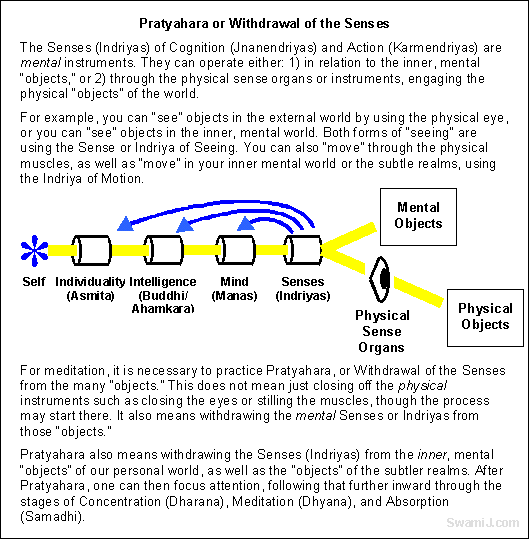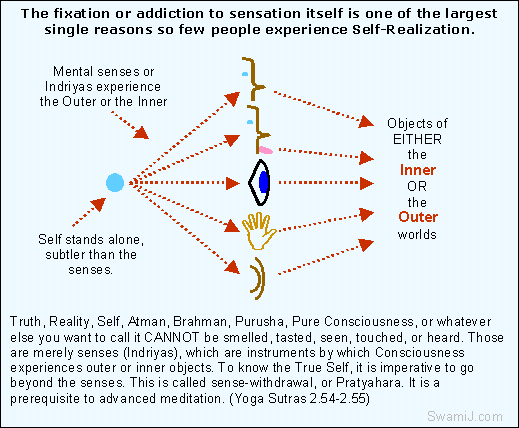|
|
|||
|
|
Yoga
Sutras 2.54-2.55:
|
||
|
The willingness or
unwillingness |
2.54
When the mental organs of senses and actions (indriyas) cease to be
engaged with the corresponding objects in their mental realm, and
assimilate or turn back into the mind-field from which they arose, this is called pratyahara, and is the fifth step.
(sva vishaya asamprayoge chittasya svarupe anukarah iva indriyanam
pratyaharah)
- sva = their own
- vishaya = objects, region, spheres, realms, fields
- asamprayoge = not coming into contact with, non-conjunction, cessation of engagement
- chittasya = of the mind field
- svarupe = own form, own nature (sva = own; rupe = form, nature)
- anukarah = imitate, resemble, follow, be engaged with
- iva = like, as though, as it were
- indriyanam = mental organs of actions and senses (indriyas)
- pratyaharah = withdrawal of the indriyas (the senses), bringing inward
See also the extensive article:
Training the Ten Senses or Indriyas
Sense withdrawal is a mental function: Withdrawing the senses does not mean just regulating the physical sense organs, such as closing the eyelids or sitting physically still. The senses are a mental function, and whenever that mental function is drawn to the objects of the mind field, there is active engagement of the senses. It doesn't really matter whether that mental object is coming from the outside (such as through the eyes), or arising from the memory. It is this internal withdrawal of sensory attention to the mental objects that is the process of pratyahara.
Indriyas are senses and actions: The senses that are withdrawn in pratyahara are called indriyas, and involve both cognition and expression. There are five means of cognition and five means of expression, and these are each aligned with the lower five chakras. It is extremely important point to understand that senses or indriyas means cognition and expression. There is an indwelling witness and an external world, and we are wanting to temporarily suspend all interaction (sensory and expression) with the external, so as to experience the depths of meditation. In addition to temporarily suspend external contact, we also want to temporarily suspend sensory contact with the images and impressions that arise in the mental field or on the mental screen. This pratyahara allows the depth of the last three rungs of Yoga to come (3.1-3.3).

Cessation of engagement, not suppression: Sense withdrawal means that the senses cease to be engaged or connected to the objects traveling in the train of the mind. It does not mean the suppression, repression, or stopping of those thoughts. They may naturally slow down or decrease to some degree, but the method itself is to break the contact, to cease connecting with the thought patterns. This means allowing thoughts to flow without interruption, while the senses are simply not diverted into those thoughts. (See the article on Intentionally Inviting Thoughts)
Following the queen bee: The senses are said to follow the mind in the same way the hive of bees follows the queen bee. Wherever she goes, they will follow. Similarly, if the mind truly goes inward, the senses will come racing behind.
Unwillingness to withdraw the senses: It is very common for people to be completely unwilling to withdraw the senses, even to the point of intense anger at any suggestion to do so. We can so cling to our sensory experience and the senses themselves that we might insist that being in nature is called meditation, that listening to music is called meditation, or that having internal visions is called meditation.
Clinging to sensing itself: Clinging to the senses does not just mean that we are engaged with the objects of the external world. Withdrawal of the senses for meditation does not just meaning closing the eyes and sitting in a quiet room. Rather, the clinging has to do with attachment to the process of sensing itself, and withdrawal of the senses literally means the cessation of seeking the sensing experiences through those senses, in relation to both external physical objects and internal mental objects. It means suspending all use of the inner instruments of smelling, tasting, seeing, touching and hearing, whether directed to the outer or the inner.
Dividing line between true meditation and mere relaxation: The willingness or unwillingness to be open to this withdrawal is a significant dividing line between those who experience the depths of meditation and those who merely achieve some degree of mental relaxation. Very few will opt for the depths of meditation, which comes with sense withdrawal or pratyahara. Others will pretend they are meditating, even writing books about meditation, while actually experiencing only the surface levels of physical relaxation.
2.55
Through that turning inward of the organs of senses and actions (indriyas)
also comes a supreme ability, controllability, or mastery over those
senses inclining to go outward towards their objects.
(tatah parama vashyata indriyanam)
- tatah = then, thereby, thence, from that
- parama = highest, supreme, ultimate, perfected
- vashyata = mastery, control, being willed
- indriyanam = of the mental organs of actions and senses (indriyas)
Practice reduces sensory inclinations: The repeated practice of pratyahara at meditation time brings a generalized lessening of the inclination of the senses being drawn towards and into the objects of the mind field. As the tendency towards the mental objects decreases with practice, the degree of mastery (vashyata) increases to its highest (parama) level.
Mastery over inclination towards objects: As the inclination of the senses towards the mental objects is mastered, there also comes regulation in relation to the physical objects of the world as well.
Like breaking a bad habit: Think of some bad habit you want to break. If you just stop the external action, the continued inner desire might lead to frustration. It is better that the mental habit is broken and then the physical action part of the habit comes naturally as a result of the mental control. In other words, if the mental sensory engagement does not happen, neither will the physical. For meditation, temporarily breaking the connection between the senses and their objects allows the attention to be able to focus and go inward.
------- This site is devoted to
presenting the ancient Self-Realization path of
the Tradition of the Himalayan masters in simple, understandable and
beneficial ways, while not compromising quality or depth. The goal of
our sadhana or practices is the highest
Joy that comes from the Realization in direct experience of the
center of consciousness, the Self, the Atman or Purusha, which is
one and the same with the Absolute Reality.
This Self-Realization comes through Yoga meditation of the Yoga
Sutras, the contemplative insight of Advaita Vedanta, and the
intense devotion of Samaya Sri Vidya Tantra, the three of which
complement one another like fingers on a hand.
We employ the classical approaches of Raja, Jnana, Karma, and Bhakti
Yoga, as well as Hatha, Kriya, Kundalini, Laya, Mantra, Nada, Siddha,
and Tantra Yoga. Meditation, contemplation, mantra and prayer
finally converge into a unified force directed towards the final
stage, piercing the pearl of wisdom called bindu, leading to the
Absolute.


